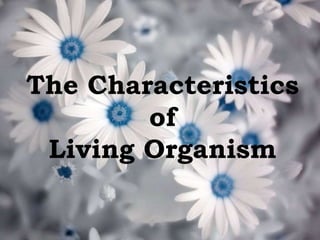
7-2. the characteristics of living organism
- 1. The Characteristics of Living Organism
- 2. For further understanding about living organisms characteristics and their differences with non-living things, let’s do observation
- 3. Observation Sheet 1. Observe the characteristics of some things (can be plants, animals, or things) near your school 2. Fill in the table below put a positive sign (+) if the object has the characteristics, and negative sign (-) if it doesn’t have the characteristics.
- 4. object Characteristics Moves Eats Breathes Grows Reprodu Excretes ces Cat Car Man Ants Bicycle Coconut tree Ball Stone Motorcyc le Hibiscus tree
- 5. a. Movement animals and humans movement can be clearly observed animals move from one place to another place because they have special organs ex. A bird has wings and feet, fish have fins to swim
- 6. • The movement of plants is very difficult to observe, because its movement is very slow and doesn’t cause any displacement. • Plants move by growing • Ex. The root is growing and extending into the ground, stem tip grow toward the sunlight, a flower bud opens when it blossoms.
- 7. b. Eat • All living things need food • But plants do not eat like animals, plants produce organic matters as their food through photosysnthesis, it’s called autotrophic 6CO2 + 6H2O C6H12O6 + 6O2 + Energy Carbon Water chlorophyl Glucose Oxygen dioxide • Green plants need certain substances, such as carbon dioxide from the air and water are taken from the soil.
- 8. • That process will produce glucose, oxygen, and energy. • Animals need another organisms to be eaten, it is called heterotrophic. • Base on their kind of food, animal divided into 3; 1. herbivores : feed on plants only 2. carnivores : feed on animals only 3. omnivores : feed on both plants and animals
- 9. c. Respiration / Breath • All living things need oxygen to breathe. • They inhale oxygen and exhale carbon dioxide and water vapor. • The inhaled oxygen is used to help the burning process of nutrient, this process is called oxidation. • Oxidation produce energy which is used to perform daily activities.
- 10. • The process of inhaling oxygen and exhaling carbon dioxide and water vapor is called respiration. C6H12O6 + 6O2 6CO2 + 6H2O • The kind of respiration organs are ; 1. Mamalians : lungs 2. Birds : lungs and air sacs 3. Fish : gills 4. Plants : stomata and lenticels
- 11. d. Irritability • Living things are sensitive to changes that occur in their surroundings. • When we are on a mountain range, we feel cold. This cold sensation is received by the sensory receptors in our skin. • A sensory reseptor is an instrument within the body which is sensitive to stimulus • Animals and humans have sensory receptors, therefore they can see, hear, smell, taste, feel, touch.
- 12. • Eyes are sensitive to light so that we can see, • ears are sensitive to the vibration so that we can hear, • nose is sensitive to odor so that we can smell, • tongue is sensitive to taste so that we can taste food, • skin is sensitive to hot or cold and to pressure, touch and wounds
- 13. • Plants do not have sensory receptors to receive stimuli, but they are sensitive to the stimuli such as light, water, gravity, and touch. • Ex. Touch-me-not plant (Mimosa pudica)will close its leaves when it is touched, shoots will grow and bend toward the direction of the light.
- 14. e. Grow and developed • If we plant a seed, it will germinate. The sprout will grow bigger and thicker. • Chicken growth starts from a chick that hatched from an egg, the chick then grow and become an adult, hen or rooster. • Human and animal growth will stop when they reach a certain age. • However, in plants, we will find that the forming of buds, leaves and flowers, happen continuously all their lives.
- 15. • Grow occurs because cells divide causing them to be more numerous which causes organisms to get bigger. • Developed occurs when cells take on specific jobs within the organism (like heart cell or brain cell)
- 16. f. Excretion • The process of removing metabolic waste in living organisms is called excretion. • Excretion organs in humans as follow ; 1. Lungs : CO2 and H2O vapor 2. Liver : excrete bile 3. Kidneys : urine 4. Skin : Sweat • Excretion in seed plants occurs through the stomata in the leaves and lenticels on the stems.
- 17. g. Reproduction • Every living organism will produce its own offspring, called reproduction. • Every species has different methods to reproduce, but the two main methods are by asexual (vegetative) and sexual (generative) reproduction.
